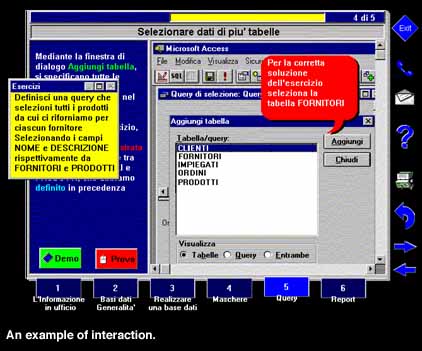Network-based Multimedia Technology for Continuous Training in Enterprises
by Paola Forcheri, Maria Teresa Molfino, Alfonso Quarati and Francesco
Riccio
The Qualification 2000 project focuses on the design and experimentation of a continuous training model, based on multimedia and networked technology, that integrates different approaches to learning: self-learning, collaborative and distance learning.
Qualification 2000 is partially supported by the EC initiative Adapt and by the Italian Ministry of Labour. Like all Adapt projects, Qualification 2000 is divided into two levels of activity: an international level, in which European partners working towards the same objective share or exchange know-how, experience, design methods, etc; a national level, in which national partners work on the common objective focusing on an application field and proposing solutions, tailored to their own country. Here, we will briefly describe the Italian part of Qualification 2000.
The rapid evolution in all technological fields means that workers in business and industry are obliged to keep up to date with the most recent developments, ie to carry out a continuous learning process. Network-based training systems can offer an efficient solution to this problem. The European Community has launched a series of initiatives to support projects aimed at exploring the possibility of helping small and medium-sized enterprises (SMEs), which constitute the core of our economy, to adopt such training models.
Our work is framed in this context. We are participating in Qualification 2000, a project partially funded by the European Community under the Adapt initiative and aimed at analysing, from an operative point of view, the potential of new technologies for providing effective continuous training in SMEs. The target of the project are SME staff members who are to be trained with respect to the changes that the new information and communication technologies have introduced in the office. The result of our activity is a training model which has two main characteristics:
- the guidelines of the model have been based on a preliminary analysis of training needs in order to respond effectively to well-defined requirements
- two different implementations have been developed so that the model can be adapted for different technological conditions.
The needs analysis, carried out through a series of interviews of both employers and employees, resulted in the training model being based on two main principles: the integration of different teaching/learning strategies so that various kinds of training needs can be satisfied; the adoption of a design and problem-solving approach in order to make staff aware of the potential of technological innovation in their particular work situation. The model consists of two parts: a set of multimedia courses; a communication environment. These parts are integrated in a distance learning environment.
The set of courses aims at helping trainees acquire information management knowledge and skills for the office. The communication environment aims at providing trainees with the possibility of contacting each other and the (distant) trainer in synchronous or asynchronous mode. By integrating these two parts, the distance learning environment allows trainees to develop, with respect to a given content, different learning paths in a single context: self-learning, collaborative learning, or distance learning with the guide of a trainer. Two different implementations were developed so that the model could be employed in different technological situations: the first was designed mainly for local use; the second is intended for a distributed training context.
The first implementation consists of four multimedia packages, which can be used on a PC in stand-alone mode for self-learning activities (see Figure), or on a local PC network, in the distance learning environment. This local application responds to a need mainly expressed by SMEs with a limited level of technological resources and which do not have Internet access: their staff needs to acquire office automation skills typical of a PC/Windows environment.

The second implementation consists of a web-based conference framework which supports the delivery of courses via Internet aimed for use on a heterogeneous network. This implementation has been designed for educational topics which are intrinsically general with respect to the hardware/software platform, and are presumed to be of interest for SMEs oriented towards a network reality. The proposal is now being experimented with a number of Italian enterprises.
The European partners of Qualification 2000 are IMA-CNR (Italy), Mittweida University (Germany), Gemme SARL (France); the national partners are IMA-CNR (Italian Promotor), ISOMAR, Porto di Savona, Vado e Imperia; Enaip Liguria; Società Funiviaria Alto Tirreno, Savona; Geo-Consult, Manocalzati; LPMconsulting, Genoa; Nuova Magrini Galileo, Savona; Unione Industriali della Provincia di Savona, The Ligurian Agency for Employment.
More information on IMA-CNR and on Qualification 2000 can be found at http://www.ima.ge.cnr.it/
Please contact:
Paola Forcheri, Maria Teresa Molfino, Alfonso Quarati and Francesco
Riccio - IMA-CNR
Tel: +39 10 6475 673/675/692
E-mail: {forcheri,
molfino, quarati, fraric}@ima.ge.cnr.it
